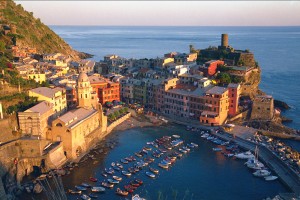 To commemorate the Smithsonian Presents Travels with Rick Steves magazine — now on sale online, and at newsstands nationwide — Rick is blogging about the 20 top destinations featured in that issue. One of those destinations is the Cinque Terre, on Italy’s Riviera.
To commemorate the Smithsonian Presents Travels with Rick Steves magazine — now on sale online, and at newsstands nationwide — Rick is blogging about the 20 top destinations featured in that issue. One of those destinations is the Cinque Terre, on Italy’s Riviera.
When I first described and recommended Italy’s Cinque Terre in the late 1970s, there was almost no tourism here. The economy was sluggish…and so were the people. Sitting in doorways seemed to be a major pastime. Menus were humble and in one language. I remember local wine sold in bottles without labels — very cheap and not very good. (And back then, “very cheap and not very good” was just fine with me.) It was a world apart, where few spoke English and the American traveler was rare. Its remoteness was the foundation of its poverty.
Today its remoteness is a draw. The five (cinque) towns are affluent, and the region is a national park. Now it seems to be on the itinerary of almost every tourist in Italy. Fancy restaurants abound, as do boutique hotels. There’s a fascinating metabolism here — because of the prime location, tourism brings locals their livelihood as reliably as the tides bring nourishment to barnacles.
Many Cinque Terre seniors who can afford to live elsewhere, do. They see the rustic nature of the towns as more of a negative than a positive. In fact, a big trend in the Cinque Terre is elderly apartment-owners moving into the big city for a more comfortable place to live out their golden years. They hire Eastern Europeans to manage their apartments, renting to tourists who arrive with each train.
On my first visit to the Cinque Terre town of Vernazza, I couldn’t afford a good restaurant meal. But I met a gentle restaurateur named Lorenzo. I’ll never forget how he looked at me, a scruffy backpacker who rarely was served a hot meal. Knowingly, he said, “Sit. You must be hungry. I’ll feed you.” I sat. And he did. Caring strangers I met in my vagabond days of travel, like Lorenzo, left a lasting impression on me. I think I see people more positively than I otherwise would have, if I had never been in need and never ventured far from home. In fact, perhaps being in need far from home is something more risk-averse people should let happen once in a while.
Shortly after my visit, Lorenzo died — in the prime of his life — a victim of cancer. For twenty years, his daughter Monica has been my best friend in Vernazza. When I look into her piercing eyes, I see Lorenzo’s compassion and love. And I’m happy to bring my groups to Monica’s family restaurant — to eat on the same castle-view perch I did back when Lorenzo wore all the hats in his little restaurant and fed scraggly vagabonds.
Every year, we need to update our guidebook listings on the five Riviera ports that make up the Cinque Terre. Because locals are so eager to get into our guidebook (considering all the business it brings), the Cinque Terre assignment can be a challenge. Like, I imagine, a boxer finds going 12 rounds exhilarating, I find it exhilarating to fend off the wanabees and collect the gems of the Cinque Terre worth recommending.
The powerful appeal of these five unique villages gives an intensity to everything about tourism here. Locals need to make their money (they shut down in the winter), travelers need to have the time of their lives, and I need to get it right for the guidebook. With my hectic research schedule and the busy lives of local chefs, one of my favorite moments is around 11 p.m., when both the chefs and I have finished our work for the day. They sit at bars with small tables facing the sea, having a strong drink and a cigarette. I take a slow walk without an agenda, no camera or notepad…just being in the Mediterranean town of my dreams. All of us are savoring the place we work to share with travelers…a little chunk of Europe that we love, season after season, as much as anyone.